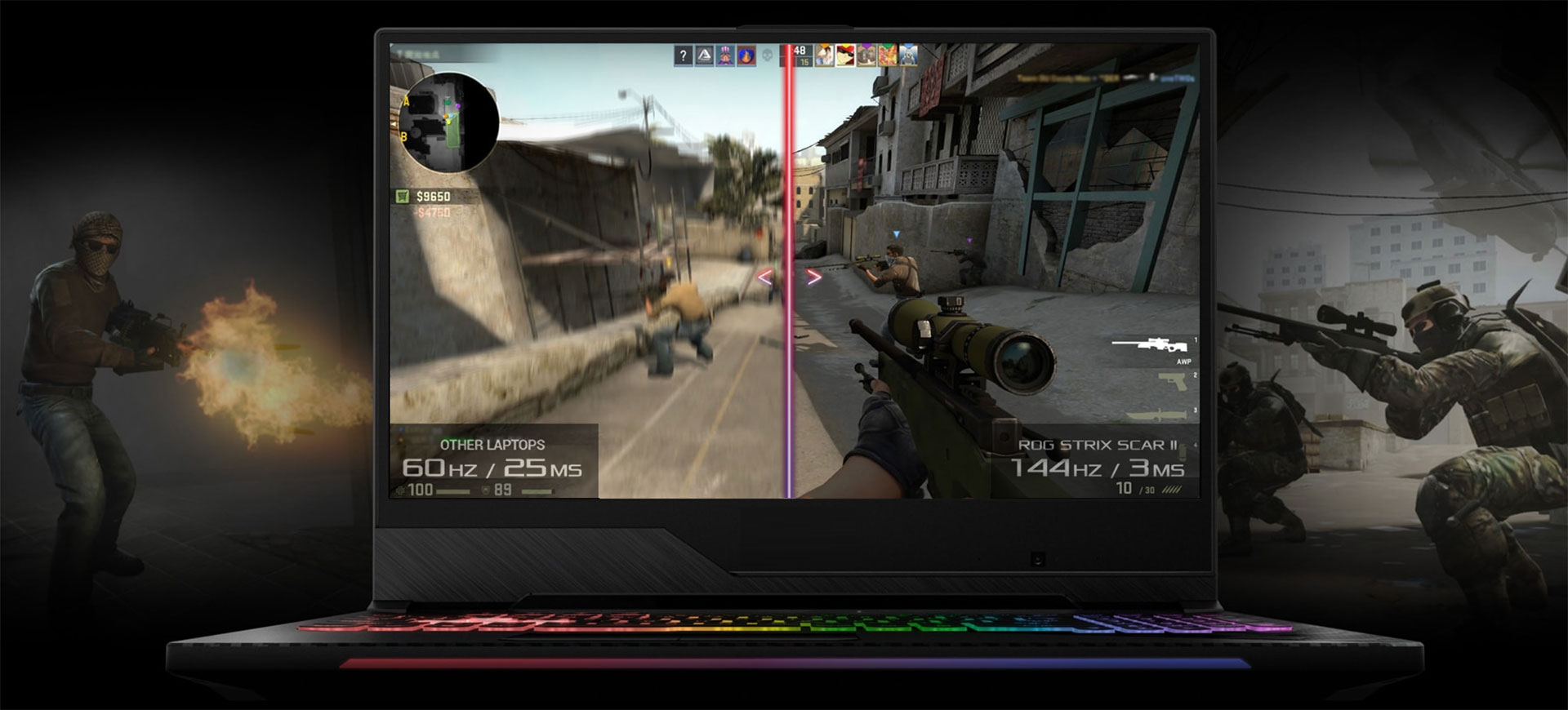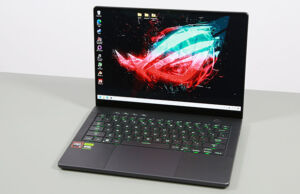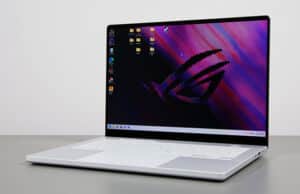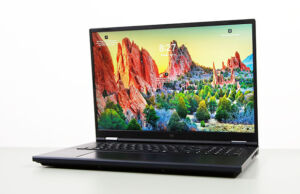Table of Contents
This article explains why a high refresh-rate screen should be a must on your gaming laptop in this day and age, and also compiles for you a complete list of all the available notebooks equipped with 144Hz or the newer 240Hz, 360Hz, and 480Hz display options, with some of their important traits and links towards more detailed reviews and guides.
If you’re not interested in the technicalities, you can jump straight to the complete list via this link, to the subsection of more recent launches with 300Hz and 360Hz panels, and the scroll down for other options.
For years, most laptop screens were standard 60 Hz panels with response times in the 20-60 ms range. In very few words, that means that the content displayed on such a screen was refreshed 60 times a second, with a delay between the time the frame was rendered on the GPU and when it was actually displayed in front of your eyes. That was, and still is perfectly fine for everyday use and movies, but a 60 Hz screen suffers from various graphics artifacts in games, such as screen tearing, especially in those that quickly transition between moving scenes.
Game developers allow us to address this problem by enabling VSync, but VSync comes with issues of its own (like increased input lag) and most competitive gamers prefer to keep it disabled.
High refresh-rate screens with faster response times are meant to alleviate tearing and stuttering without adding lag, and such panels are now available on most good-quality gaming laptops.
In all fairness, they’re still not going to completely address all the issues, but they come closer to offering a smooth and glitch-free gaming experience. In theory, that perfect gaming experience is achievable if you run a game at let’s say 144 fps on a 144 Hz screen all the time, but that’s impossible to get in practice, as frame rates are variable. And here’s where technologies like Nvidia GSync or AMD FreeSync and ActiveSync come in, which sync the screen’s refresh rate to the game’s refresh rate, making sure that the screen only refreshes when the hardware outputs new content.
Since most gaming laptops are based these days on Nvidia GPUs, there are some that offer GSync, but primarily in the higher-tier ranges, as this technology doesn’t come cheap. We’re not going to focus on GSync or FreeSync in this article, but we’ll mention which of the devices in the following list supports it.
If you’re on a tighter budget and cannot reach out for a GSync laptop, I would still recommend having a 144+ Hz panel on your to-get list, as the refresh alone will alleviate most potential gaming issues. Just make sure to pick the right hardware that can handle the games you’re interested in. If you’re into casual games, you’ll want a computer with a GTX 1050Ti/GTX 1650/RTX 3050 GPU or higher, while if you plan to run AAA titles, get at least a GTX 1060/1660Ti/RTX 3060 build.
Of course, there’s also the question of whether a 240/300/360 Hz screen is worth getting over a 144 Hz panel, and the answer is: it depends. If you’re a regular gamer, you’ll hardly tell the difference between the these options, as the jump from 144 to 240+ Hz is much more subtle than the jump from 60 to 144 Hz. On the other hand, if you’re a competitive player and you’re into fast action-paced shooters, MMOs or driving games, then every little bit is going to count and a 300/360 Hz panel will help. Just make sure to pair such a display with the kind of graphics that can actually run the titles you’re interested in at high 300+ fps.
You should also consider whether you want a TN or an IPS panel on your computer. Generically, TN screens offer shorter response times, which translate in diminished ghosting, but also narrower viewing angles and poorer colors. IPS screens on the other hand display nicer colors, get better contrast and wide viewing angles, but some of them are pretty slow, which can be a disadvantage in those fast games. The recent IPS panels are no longer slow, with many options offering an advertised response time of 3 ms (with Overdrive), so as of 2021-2022, opting for a TN panel no longer makes sense on a modern laptop, unless you’re on a very tight budget and looking to buy an older device at a good discount.
One final aspect to discuss here is the resolution of these screens. For the last years, most high-refresh rate screens have been FHD – 1920 x 1080 px resolution, but as of recently, there are also some FHD+ (1920 x 1200 px) 16:10 options, as well as a handful of QHD 120 to 240 Hz and even 4K 120Hz panel options. We’ve covered laptops with 4K 120Hz screens in this post, and we’ll also touch on the mid-tier best-balanced QHD and QHD+ options in a separate article, while in here we’ll mostly focus on the FHD 300 and 360Hz options.
With all these in mind, let’s jump to the actual list of gaming laptops with high refresh-rate screens. It includes both mid-range and high-tier options, with links towards more detailed reviews and updated configurations and prices at the time you’re reading the article.
Modern laptops with 480 Hz and 360 Hz screens
480Hz FHD panels are available as of 2022 as the fastest displays that you can get on laptops, a step-up from the 360Hz panels available in the past. We’re going to list these options separately in this section, and continue with the mainstream 240/144Hz options below. I’d still advise you to make sure that you’ll actually benefit from having a 300+Hz panel on your computer, and don’t just buy into the hype here.
You should know that 480Hz/360Hz screens are mostly only available on higher-tier configurations (RTX 3070 or 3080 or later, with very few 3060 exceptions) of a handful of laptops out there, so aiming for this sort of display will limit your options. In comparison, sub-240Hz screens are available with all sorts of mid-tier more affordable models. Also, keep in mind that most of the laptops mentioned below with an FHD 480Hz/360Hz display option are also available in other screen variants, including QHD 165/240 Hz or even 4K 120Hz.
| Model (link to reviews) | Hardware | Screen | Price |
| Acer Nitro 5 | Ryzen 9 HX + up to RTX 3080 95W | 15.6″ IPS FHD 360Hz 3ms, Optimus, matte | from $1949 |
| Acer Predator Helios 300 | 11th gen Core H + up to RTX 3070 100W | 15.6″ IPS FHD 360Hz 3ms, Optimus, matte | from $1799 |
| Acer Predator Helios 500 | 11th gen Core HK + up to RTX 3080 165W | 17.3″ IPS FHD 360Hz 3ms or QHD 165Hz, MUX and GSync, matte | from $2499 |
| Asus ROG Strix Scar 15 | Ryzen 9 HX + up to RTX 3080 130W | 15.6″ IPS FHD 360Hz 3ms or QHD 165Hz, Optimus, matte | from $1799 |
| Asus ROG Strix Scar 17 | Ryzen 9 HX + up to RTX 3080 130W | 17.3″ IPS FHD 360Hz 3ms or QHD 165Hz, Optimus, matte | from $2499 |
| Dell G15 Special Edition | 11th gen Core H + up to RTX 3060 115W | 15.6″ IPS FHD 360Hz 3ms, MUX, matte | from $1499 |
| Dell Alienware m15 | 11th gen Core H + up to RTX 3070 125W | 15.6″ IPS FHD 360Hz 5ms, MUX and GSync, matte | from $2109 |
| Dell Alienware m17 | 11th gen Core H + up to RTX 3070 140W | 17.3″ IPS FHD 360Hz 1ms or 480Hz 1ms, MUX and GSync, matte | from $2349 |
| Dell Alienware X15 | 11th gen Core HK + up to RTX 3070 110W | 15.6″ IPS FHD 360Hz 1ms, MUX and GSync, matte | from $1799 |
| Dell Alienware X17 | 11th gen Core HK + up to RTX 3080 165W | 17.3″ IPS FHD 360Hz or 480Hz 1ms, MUX and GSync, matte | from $2699 |
| Gigabyte Aorus 15P | 11th gen Core H + up to RTX 3080 130W | 15.6″ IPS FHD 360Hz 3ms, MUX, matte | from $1799 |
| MSI GE76 Raider | 11th gen Core HK + up to RTX 3080 155W | 17.3″ IPS FHD, 360Hz, MUX, matte | from $2599 |
| MSI GS66 Stealth | 11th gen Core HK + up to RTX 3080 95W | 15.6″ IPS FHD, 360Hz, MUX, matte | from $3299 |
| MSI GS76 Stealth | 11th gen Core HK + up to RTX 3080 95W | 17.3″ IPS FHD, 360Hz 3ms, MUX, matte | from $2399 |
| Razer Blade 15 Advanced | 11th gen Core H + up to RTX 3080 100W | 15.6″ IPS FHD 360Hz 3ms or QHD 240Hz, MUX and GSync, matte | from $2699 |
| Razer Blade 17 | 11th gen Core H + up to RTX 3080 130W | 17.3″ IPS FHD 360Hz 3ms or QHD 240Hz, MUX and GSync, matte | from $2799 |
And here’s the second part of this section with laptops available with 300Hz screens. We’re not mentioning those already listed above, but in some cases, those might also be available with FHD 300Hz displays on mid-tier 3060 configurations.
That aside, I’ve mostly included latest-gen products in here, and only a handful of the older 2019-2020 laptops that are still shipping with 300 Hz displays.
| Model (link to reviews) | Hardware | Screen | Price |
| Acer Predator Triton 500 | 10th gen Core H + up to RTX 2080 Super 90W | 15.6″ IPS FHD, 300Hz 3ms, MUX and GSync, matte | from $1499 |
| Asus ROG Strix G15 | Ryzen 9 HX + up to RTX 3070 130W | 15.6″ IPS FHD, 300Hz 3ms, Optimus, matte | from $1199 |
| Asus ROG Strix G15 Advantage | Ryzen 9 HX + up to RX 6800M 165W | 15.6″ IPS FHD, 300Hz 3ms, matte | from $1699 |
| Asus ROG Strix G17 | Ryzen 9 HX + up to RTX 3070 130W | 17.3″ IPS FHD, 300Hz 3ms, Optimus, matte | from $1299 |
| Asus ROG Zephyrus S15 | 10th gen Core H + up to RTX 2080 Super 100W | 15.6″ IPS FHD, 300Hz 3ms, MUX and GSync, matte | from $1799 |
| Asus ROG Zephyrus DUO | Ryzen 9 HX + up to RTX 3080 130WW | 15.6″ IPS FHD, 300Hz 3ms, Optimus, matte | from $2999 |
| Asus ROG Zephyrus S GX701GX | 10th gen Core H + up to RTX 2080 Super 110W | 17.3″ IPS FHD, 300Hz 3ms, MUX and GSync, matte | from $2499 |
| Gigabyte Aorus 17G | 11th gen Core H + up to RTX 3070 105W | 17.3″ IPS FHD, 300Hz 3ms, MUX, matte | from $2199 |
| MSI GE66 Raider | 11th gen Core HK + up to RTX 3080 130W | 15.6″ IPS FHD, 300Hz 3ms, MUX, matte | from $1599 |
| MSI GP76 Leopard | 11th gen Core HK + up to RTX 3070 140W | 17.3″ IPS FHD, 300Hz 3ms, MUX, matte | from $2299 |
Update: As of recently, most premium-tier laptops are also available with a middle-ground QHD or QHD+ panel with 165Hz or 240Hz refresh rate. The increased resolution allows for sharper image quality, while the 165-240Hz refresh should still suffice for the vast majority of gamers here. We’ll have a list of gaming laptops with this sort of screen in a separate article.
Lightweight laptops with 144Hz and 240 Hz screens
| Model (link to reviews) | Hardware | Screen | Price |
| Acer Predator Triton 500 | 9th gen Core H + up to RTX 2080MQ | 15.6″ IPS FHD, 144 Hz 3ms (~8 ms GTG response), dual GSync/Optimus, matte | from $1699 |
| Acer Predator Triton 700 | 7th gen Core HQ + GTX 1080MQ | 15.6″ IPS-level FHD, 120 Hz, ~30 ms BTW response, GSync, matte | from $1199 |
| Alienware m15 | 9th gen Core H + up to RTX 2080MQ | 15.6″ IPS FHD, 240 Hz 7ms or 144 Hz 9ms (~18 ms GTG response), matte | from $1499 |
| Alienware m17 | 9th gen Core H + up to RTX 2080MQ | 17.3″ IPS FHD, 240 Hz 7ms or 144 Hz 9ms(~18 ms GTG response), matte | from $1699 |
| Asus ROG Zephyrus M GM501 | 8th gen Core H + up to GTX 1080 | 15.6″ IPS FHD, 144 Hz, ~10.5 ms BTW response, matte | from $1599 |
| Asus ROG Zephyrus S GX531 | 9th gen Core H + up to RTX 2080MQ | 15.6″ IPS FHD, 240 Hz 3ms or 144 Hz 3ms (~7 ms GTG response), Optimus, matte | from $1999 |
| Asus ROG Zephyrus S GX502 | 9th gen Core H + up to RTX 2070 | 15.6″ IPS FHD, 240 Hz 3ms or 144 Hz 3ms (~7 ms GTG response), dual GSync/Optimus, matte | from $1899 |
| Asus ROG Zephyrus M GU502 | 9th gen Core H + up to RTX 2060MQ | 15.6″ IPS FHD, 144 Hz 3ms (~7 ms GTG response), matte | from $1799 |
| Asus ROG Zephyrus G GA502 | Ryzen 7 + GTX 1660Ti | 15.6″ IPS-level FHD, 120 Hz (~34 ms GTG response), matte | from $1199 |
| Asus ROG Zephyrus S GX701 | 9th gen Core H + up to RTX 2080MQ | 17.3″ IPS FHD, 300, 240 or 144 Hz 3ms, GSync, matte | from $2499 |
| Clevo P955ER / SAGER NP8955 | 8th gen Core H + GTX 1070MQ | 15.6″ IPS FHD, 144 Hz, ~16 ms GTG response, matte | from $1599 |
| Clevo PA71ES / Sager NP375 / Eluktronics PA71HS | 8th gen Core H + RTX 2070 | 17.3″ IPS FHD, 144 Hz, GSync matte | from $1799 |
| Gigabyte Aero 15 | 8th gen Core H + up to RTX 2080MQ | 15.6″ IPS FHD, 144 Hz (~16.5 ms GTG response), matte | from $1899 |
| Gigabyte Aero 15 Classic | 9th gen Core H + up to RTX 2080MQ | 15.6″ IPS FHD, 240 Hz (~15 ms response) or 144 Hz (~16.5 ms GTG response), matte | from $1699 |
| Gigabyte Aero 17 | 9th gen Core H + up to RTX 2080MQ | 17.3″ IPS FHD, 240 Hz or 144 Hz, matte | from $2299 |
| HP Omen 15t | 9th gen Core H + up to RTX 2070MQ | 15.6″ IPS FHD, 240 Hz or 144 HZ (~14 ms GTG response), matte | from $1299 |
| MSI GS65 Stealth Thin | 9th gen Core H + up to RTX 2080MQ | 15.6″ IPS FHD, 240 Hz or 144 Hz 3ms (~7.5 ms GTG response), matte | from $1899 |
| MSI GS75 Stealth Thin | 9th gen Core H + up to RTX 2080MQ | 17.3″ IPS FHD, 240 Hz or 144 Hz 3ms (~7.5 ms GTG response), matte | from $1949 |
| Razer Blade 15 Advanced | 9th gen Core H + RTX 2080MQ | 15.6″ IPS FHD, 240 Hz (~13 ms GTG response) or 144 Hz (~16 ms GTG response), matte | from $2299 |
| Razer Blade Pro 17 | 9th gen Core H + RTX 2080MQ | 17.3″ IPS FHD 144 Hz 3ms (~7 ms GTG response), matte | from $2699 |
And here’s a complete list of full-size laptops with 120/144/240 Hz screens, latest generations hardware and GSync (in some cases).
Full-Size laptops with 144Hz or 240Hz screens
| Model (link to reviews) | Hardware | Screen | Price |
| Acer Predator Helios 300 15 | 9th gen Core H + up to RTX 2070MQ | 15.6″ IPS FHD, 144 Hz 3ms (~8 ms GTG response), matte | from $1199 |
| Acer Predator Helios 300 17 | 9th gen Core H + up to RTX 2070MQ | 17.3″ IPS FHD, 144 Hz 3ms (~8 ms GTG response), matte | from $1299 |
| Acer Predator Helios 500 17 | 8th gen Core HK + GTX 1070 OC, or AMD | 17.3″ IPS FHD, 144 Hz (~10 ms GTG response), GSync matte | from $1499 |
| Alienware Area 51m | 9th gen Core K + up to RTX 2080 | 15.6″ IPS FHD, 144 Hz 7ms (~14 ms GTG response), matte | from $2299 |
| Aorus 15 | 9th gen Core H + up to RTX 2070 | 15.6″ IPS FHD, 240 Hz (~16 ms GTG response) or 144 Hz, matte | from $1399 |
| Aorus X5 | 8th gen Core H + RTX 1070 | 15.6″ IPS FHD, 144 Hz (~19 ms GTG response), GSync, matte | from $2599 |
| Aorus X7 | 8th gen Core H + GTX 1080 | 17.3″ IPS FHD, 144 Hz (~18 ms GTG response), GSync, matte | from $2999 |
| Aorus X9 | 8th gen Core HK + GTX 1080 | 17.3″ IPS FHD, 144 Hz (~18 ms GTG response), GSync, matte | from $3499 |
| Asus TUF FX504 series | 8th gen Core H + up to GTX 1060 | 15.6″ TN FHD, 120 Hz(~40 ms GTG response), matte | from $699 |
| Asus TUF FX505 series | Ryzen + up to GTX 1160 | 15.6″ IPS-level FHD, 120 Hz(~40 ms GTG response), matte | from $899 |
| Asus TUF FX705 series | Ryzen + up to GTX 1160 | 17.3″ IPS-level FHD, 120 Hz(~44 ms GTG response), matte | from $999 |
| Asus ROG G703 | 9th gen Core HK + RTX 2080 OC | 17.3″ IPS FHD, 144 Hz3ms (~7 ms GTG response), GSync, matte | from $3299 |
| Asus ROG Strix GL503 Hero 15 | 8th gen Core H + up to GTX 1060 | 15.6″ IPS FHD, 120 Hz, matte | from $999 |
| Asus ROG Strix GL504 Hero II 15 | 8th gen Core H + RTX 2060 | 15.6″ IPS FHD, 144 Hz 3ms (~8 ms GTG response), matte | from $1199 |
| Asus ROG Strix GL504 Scar II 15 | 8th gen Core H + up to RTX 2070 | 15.6″ IPS FHD, 144 Hz 3ms (~8 ms GTG response), matte | from $1499 |
| Asus ROG Strix G531 15 | 9th gen Core H + up to RTX 2070 | 15.6″ IPS-level FHD, 120 Hz, matte | from $1499 |
| Asus ROG Strix G531 Hero III 15 | 9th gen Core H + up to RTX 2070 | 15.6″ IPS FHD, 240 Hz 3ms or 144 Hz 3ms, matte | from $1799 |
| Asus ROG Strix G531 Scar III 15 | 9th gen Core H + up to RTX 2070 | 15.6″ IPS FHD, 240 Hz 3ms or 144 Hz 3ms, matte | from $1799 |
| Asus ROG Strix GL703 Hero 17 | 8th gen Core H + RTX 2060 | 17.3″ TN FHD, 120 Hz, ~7.5 ms BTW response, matte | from $1199 |
| Asus ROG Strix GL703 Scar 17 | 8th gen Core H + RTX 2070 | 17.3″ IPS FHD, 144 Hz 3ms (~7 ms GTG response), matte | from $1899 |
| Asus ROG Strix GL704 Scar II 17 | 8th gen Core H + up to RTX 2070 | 17.3″ IPS FHD, 144 Hz 3ms (~7 ms GTG response), matte | from $1699 |
| Asus ROG Strix G531 17 | 9th gen Core H + up to RTX 2070 | 17.3″ IPS-level FHD, 120 Hz, matte | from $1499 |
| Asus ROG Strix G731 Hero III 17 | 9th gen Core H + up to RTX 2070 | 17.3″ IPS FHD, 240 Hz 3ms or 144 Hz 3ms, matte | from $1999 |
| Asus ROG Strix G731 Scar III 17 | 9th gen Core H + up to RTX 2070 | 17.3″ IPS FHD, 240 Hz 3ms or 144 Hz 3ms, matte | from $1999 |
| Clevo NP850EK1 /Sager NP6853 | 8th gen Core H + up to GTX 1060 | 15.6″ TN FHD, 120 Hz, ~7 ms BTW response, matte | from $1249 |
| Clevo N870EP6 / Sager NP7871 | 8th gen Core H + up to GTX 1060 | 17.3″ IPS FHD, 144 Hz, ~12 ms BTW response, matte | from $1249 |
| Clevo P775TM-G / Sager NP9175 | 8th gen Core K + GTX 1080 | 17.3″ IPS FHD, 144 Hz, GSync matte | from $2399 |
| Dell G3 Gaming 15 | 9th gen Core H + GTX 1660Ti | 15.6″ IPS FHD, 144 Hz (~17 ms GTG response), matte | from $1349 |
| Dell G5 Gaming 15 | 9th gen Core H + up to RTX 2060 | 15.6″ IPS FHD, 144 Hz (~17 ms GTG response), matte | from $1299 |
| Dell G7 Gaming 15 | 9th gen Core H + up to RTX 2080MQ | 15.6″ IPS FHD, 144 Hz (~17 ms GTG response), matte | from $1599 |
| Dell G7 Gaming 17 | 9th gen Core H + up to RTX 2080MQ | 17.3″ IPS FHD, 144 Hz (~17 ms GTG response), matte | from $1649 |
| HP Pavilion Gaming 15 | 9th gen Core H + up to GTX 1660Ti MQ | 15.6″ IPS FHD, 144 Hz (~18 ms GTG response), matte | from $1099 |
| HP Pavilion Gaming 17 | 9th gen Core H + up to GTX 1660Ti MQ | 15.6″ IPS FHD, 144 Hz (~17 ms GTG response), matte | from $1199 |
| HP Omen X 2S 15 | 9th gen Core H + up to RTX 2080MQ | 15.6″ IPS FHD, 144 or 240 Hz, matte | from $2099 |
| HP Omen 17 | 9th gen Core H + up to RTX 2070 | 17.3″ IPS FHD, 144 Hz, GSync, matte | from $1399 |
| Lenovo Legion Y540 15 | 9th gen Core H + up to RTX 2060 | 15.6″ TN FHD, 144 Hz, matte | from $1099 |
| Lenovo Legion Y540 17 | 9th gen Core H + up to RTX 2060 | 17.3″ TN FHD, 144 Hz, matte | from $1149 |
| Lenovo Legion Y740 15 | 9th gen Core H + up to RTX 2070MQ | 15.6″ TN FHD, 144 Hz (~18 ms GTG response), matte | from $1549 |
| Lenovo Legion Y740 17 | 9th gen Core H + up to RTX 2080MQ | 17.3″ TN FHD HDR, 144 Hz (~15 ms GTG response), matte | from $1549 |
| MSI GE63 Raider | 8th gen Core H + up to RTX 2080 | 15.6″ TN FHD, 120 Hz (~8 ms GTG response), matte | from $1649 |
| MSI GE65 Raider | 9th gen Core H + up to RTX 2070 | 15.6″ IPS FHD, 240 Hz, matte | from $1799 |
| MSI GE73 Raider | 8th gen Core H + up to GTX 1070 | 17.3″ TN FHD, 120 Hz, ~13.5 ms BTW response, matte | from $1699 |
| MSI GE75 Raider | 9th gen Core H + up to RTX 2080 | 15.6″ IPS FHD, 144 Hz (~8 ms GTG response), matte | from $1899 |
| MSI GL63 | 9th gen Core H + up to RTX 2060 | 15.6″ IPS FHD, 144 Hz, matte | from $1399 |
| MSI GL73 | 9th gen Core H + up to RTX 2060 | 17.3″ IPS FHD, 144 Hz, matte | from $1499 |
| MSI GP63 Leopard | 8th gen Core H + up to GTX 1060 | 15.6″ TN FHD, 120 Hz, ~8.5 ms BTW response, matte | from $1199 |
| MSI GP75 Leopard | 9th gen Core H + up to RTX 2060 | 17.3″ IPS FHD, 144 Hz 3ms (~8 ms GTG response), matte | from $1499 |
| MSI GT63 Titan | 8th gen Core H + up to RTX 2080 | 15.6″ TN FHD, 120 Hz (~8 ms GTG response), GSync, matte | from $2199 |
| MSI GT75 Titan | 9th gen Core K + RTX 2080 | 17.3″ IPS FHD, 144 Hz 3ms (~7 ms GTG response), GSync, matte | from $2799 |
| MSI P65 Creator | 9th gen Core H + up to RTX 2070 | 15.6″ IPS FHD, 144 Hz (~16 ms GTG response), matte | from $1999 |
*advertised BTW response time, not measured
The other BTW (Black to White) response time numbers above are based on measured test results from notebookcheck.net and laptopmedia.com, as we do not currently have the capabilities to test these in our reviews. Take them with a grain of salt and do your own research if response times are a crucial factor in your decision process.
That’s about it for this article on gaming laptops with fast 144Hz, 240Hz, 360Hz, or even 480Hz screens. We’re constantly updating the list, but if you spot any issues or any product that should be in here and is not, please get in touch in the comments section below. That aside, if you’re interested in more details on gaming notebooks, our master article on the best gaming laptops of the moment is a good place to start your research.














al bundy
April 19, 2019 at 2:11 pm
Could someone recommend me concrete 15.6"/IPS display part numbers with manufacturer names with low response times such as some of the above laptop models have?
The response time of my current panel is 30 ms and it gives me terrible ghosting. I would like to upgrade my laptop with a faster panel to reduce ghosting.
Also, is there a way to achieve overdrive with a given LCD panel (not an external monitor)?
Thanks,
Al
Sunny
July 6, 2019 at 4:00 pm
Iam thinking of getting a non Max q rtx 2070. My options are the Gigabyte aorus x9 15 and Asus rog scar ii. Both have 144 hz display, with aorus having extra m2 slot and 2tb HDD. Is it worth getting the 3 Ms on asus, or is there no difference between the both? Thank you.
Andrei Girbea
July 8, 2019 at 9:45 am
I haven't reviewed the aorus with rtx 2070, but I have the SCar ii over here: https://www.ultrabookreview.com/25079-asus-gl504gw-scar-review/ . In general, the ROGs should have better cooling, even if components still run fairly hot.
Not sure what you mean with that last questions, what are the 3 Ms?
Cybort
July 18, 2019 at 9:57 am
I think it's the 3ms screen.
asad
December 12, 2019 at 3:25 am
higher refresh rate will now pick up, judging by their emergence in flagship mobile phones, so make a dedicated section for higher refresh rate laptops not just for gaming but everyday use and creators.
mirage
January 4, 2021 at 2:28 pm
what about the ACER NITRO 5 AN515-55-59U5, It too have 144hz/3ms display!!